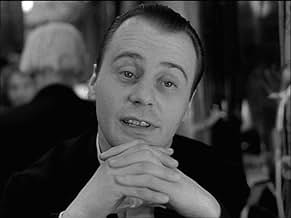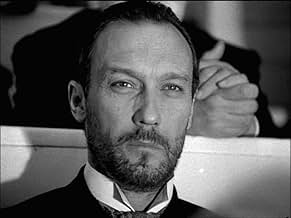Az én XX. századom
- 1989
- 1h 42min
CALIFICACIÓN DE IMDb
7.0/10
2.1 k
TU CALIFICACIÓN
Agrega una trama en tu idiomaTwo twin sisters, who grew up separately, Dóra, a pseudo-aristocrat, and Lili, an anarchist bomber, are reunited through Z, a mysterious traveller of the luxurious Orient-Express.Two twin sisters, who grew up separately, Dóra, a pseudo-aristocrat, and Lili, an anarchist bomber, are reunited through Z, a mysterious traveller of the luxurious Orient-Express.Two twin sisters, who grew up separately, Dóra, a pseudo-aristocrat, and Lili, an anarchist bomber, are reunited through Z, a mysterious traveller of the luxurious Orient-Express.
- Dirección
- Guionista
- Elenco
- Premios
- 1 premio ganado en total
- Dirección
- Guionista
- Todo el elenco y el equipo
- Producción, taquilla y más en IMDbPro
Opiniones destacadas
A film of great charm, beauty and invention and yet it's almost totally unknown, Ildiko Enyedi's debut "My Twentieth Century" is ripe for rediscovery. It's the story of twin girls, Dora and Lili, (both played by Dorotha Segda), born in Budapest in 1880 but separated in early childhood, one growing up to be an anarchist, the other a courtesan. It's also the story of the inventions of one Thomas Edison and it's wonderfully shot in black and white, with nods to the silent cinema, by Tibor Mathe. Darting all over the place with no concessions to reality it feels, at times, like it could have been made by Max Ophuls early in his career and at other times like something from the Czech New Wave and you might even be forgiven for thinking that Miguel Gomes may have seen this before making "Tabu". Gorgeous, mysterious and unmissable.
Hungary's submission for Best Foreign Language Film to the 62nd Academy Awards is a kaleidoscopic look at the turn of the last century. Ildikó Enyedi's "Az én XX. Századom" ("My 20th Century" in English) mostly focuses on a pair of sisters - one an aristocrat, the other an anarchist - while also showing the technological innovations that came about as the nineteenth century was ending. The movie incorporates cats, a donkey, and even sexuality to tell its multi-layered story, all done to perfection. It might be hard to take in, but you should still see it. The cast includes Dorota Segda, Oleg Yankovsky, Paulus Manker, Péter Andorai, Gábor Máté and Gyula Kéry.
It was probably appropriate to release this depiction of a new era just as Hungary was about to enter a new era, breaking free of the Soviet boot. Enyedi put off directing for a while after this, returning with 2017's Academy Award-nominated "On Body and Soul", about a relationship between two people suffering from disabilities.
It was probably appropriate to release this depiction of a new era just as Hungary was about to enter a new era, breaking free of the Soviet boot. Enyedi put off directing for a while after this, returning with 2017's Academy Award-nominated "On Body and Soul", about a relationship between two people suffering from disabilities.
I have the LaserDisk. For those who didn't understand, it's an allegory for the 20th Century of Hungary. The two leading female roles are representative of a dichotomy of Hungarian National thought. A key scene is the one in which the leading lady (Dora?) allows herself to have sex with (or maybe seduces?)the male lead (who represents the Hungarian people/nation itself) and then allows herself to be re-serviced on board the ship (Fiume) by the German. Hungarian history is replete with a love/hate relationship with Germany. The Hungarian people have been very religious (read the lyrics to the Hungarian National Hymn), hence the intervention of the angels to protect the two girls. Hungary, in all its national aspirations and doubts, is protected by God.
The explanation is the scene in the hall of mirrors, in the angels' discussion of the male lead's dilemma, i.e. of loving both girls (or bring trapped by the Hungarian national dichotomy) but not understanding why or how to resolve his problem.
The ending is confusing. It appears to be a boat's passage into a limitless lake or ocean, perhaps suggesting an uncertain future for the nation and its people.
The explanation is the scene in the hall of mirrors, in the angels' discussion of the male lead's dilemma, i.e. of loving both girls (or bring trapped by the Hungarian national dichotomy) but not understanding why or how to resolve his problem.
The ending is confusing. It appears to be a boat's passage into a limitless lake or ocean, perhaps suggesting an uncertain future for the nation and its people.
electricity...the stars talking...a dog with electrodes on its head...a whore and a terrorist...the pigeons...the donkey...siberia...what the freakin hell? this one either went right over my head. nothing else to say about this one but i'm supposed to fill up 4 lines. rating -6/10.
Dorota Segda has a go at some entertaining multi-tasking in this enjoyable thriller about the different paths taken by two poverty-stricken orphans whom we first meet trying to sell matches in the depths of a snowy winter in Budapest. They are identical twins "Dóra" and "Lili" who happened to be born just as Thomas Edison demonstrated his first ever light bulb. They are very close until separated - unwillingly - with one embarking on a more privileged life and the other taking a more onerous route to adulthood. Both, though, have one thing in common - they can think on their feet. "Dòra" just loves to fleece the wealthy and dim aristocracy who are enamoured of her charm and beauty; "Lili" on the other hand hates the whole concept of that entitled society and is very ready with a fizzing bomb to bring their whole edifice crashing down. Many years later, the two are unexpectedly reunited on the Orient Express thanks to the enigmatic "Z" (Oleg Yankovskiy) and what ensues is quite a playful exercise in sibling reconciliation via a fairly circuitous route! I thought the delicate imagery had something of the von Sternberg to it. The monochrome camerawork simply loving the vulnerability of Segda's characters one minute, then enticing the mischief from her the next. The dialogue is actually quite sparing, but what there is manages to take a swipe at a society of the have and the have nots as well as those who ply their trade capitalising on the vanity (or hormones) of the would-be sophisticates. On the face of it, the narrative can look a bit of a mess but I thought auteur Ildikó Enyedi managed to knit the threads together quite agreeably.
¿Sabías que…?
- TriviaVoted as one of the "12 Best Hungarian Films" ("New Budapest 12") by Hungarian filmmakers and critics in 2000.
- ErroresThe film takes place around 1900. In the projection room scene, among Méliès' films, there is an extract from "The General" by Buster Keaton which was shot in 1926. That is 26 years later.
- ConexionesFeatured in Final Cut: Ladies and Gentlemen (2012)
- Bandas sonorasMacbeth, Act 3: Coro e ballabile
Ondine e silfidi""
Written by Giuseppe Verdi
Performed by Andrea Mate, Budapest Symphony Orchestra, Hungarian Radio and Television Chorus, Istvan Gati, Janos Bandi, Janos Tóth, Katalin Pitti, Kolos Kováts, Lamberto Gardelli, Mária Zádori, Peter Kelen, Piero Cappuccilli, Sylvia Sass, Tamás Bátor
Selecciones populares
Inicia sesión para calificar y agrega a la lista de videos para obtener recomendaciones personalizadas
- How long is My Twentieth Century?Con tecnología de Alexa
Detalles
- Fecha de lanzamiento
- Países de origen
- Idioma
- También se conoce como
- My Twentieth Century
- Locaciones de filmación
- Productoras
- Ver más créditos de la compañía en IMDbPro
Taquilla
- Total en EE. UU. y Canadá
- USD 682,016
- Tiempo de ejecución1 hora 42 minutos
- Color
- Mezcla de sonido
- Relación de aspecto
- 1.33 : 1
Contribuir a esta página
Sugiere una edición o agrega el contenido que falta

Principales brechas de datos
By what name was Az én XX. századom (1989) officially released in India in English?
Responda


























